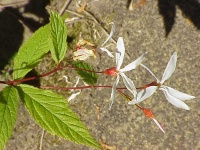Login to edit
An inheritance group references a group of content elements. It extends the functionality of the element group by passing on the content element configuration down the navigation tree.
OpenCms 8.5 Demo Content
Search for content
Page subscription
Most Recent News
Exciting new Acacia variety discovered
Sep 24, 2012
An element group (like this one) allows you to group multiple content elements together and share them on several pages.
Gillenia

Gillenia (syn. Porteranthus) is a genus of two species of perennial herbs in the Rosaceae family.
Common names for plants in this genus include: Bowman's root, Indian-physic, American ipecac. This genus is endemic to dry open woods with acidic soils in eastern North America. Both plants are subshrubs with exposed semi-woody branches and serrated leaves; the larger lower leaves are divided into palmately arranged leaflets. Plants bloom in May, June, or July; blooms are composed of five slender white petals which are loosely arranged and typically appear slightly twisted and limp as if they were wilted. The flowers mature into small capsules. These plants are often planted as ornamentals and used medicinally as an herbal remedy.
Traditionally this genus is considered a member of subfamily Spiraeoideae, but it was moved to subfamily Maloideae, when it became apparent that it comes from the lineage which lead to the Maloideae (which arose from within the Spiraeoideae). More recently, subfamily Spiraeoideae has been expanded to include all of the Maloideae (as well as subfamily Prunoideae).
Gillenia has a haploid chromosome number of 9; the rest of the Maloideae have a haploid chromosome number of 17 (which was probably produced from a Gillenia-like ancestor by doubling the genome and then losing a chromosome). Flower structure and fossil evidence also point to Gillenia sharing distinctive features with the Maloideae. Another similarity between Gillenia and the rest of the Maloideae is susceptibility to Phragmidium fungus. Differences between Gillenia and most Maloideae include the chromosome number and the latter being solely woody pome bearing plants (Gillenia is herbaceous).
This article uses material from the Wikipedia article Gillenia and is licensed under the GNU Free Documentation License.


